Ash's Film Room
Film Room: Here’s how the Avs can win Game 5

So, just what is going wrong? The Avs started the series looking like the team we thought should show up. But over the course of the last eight periods, Vegas has managed to outshoot Colorado 116 to 62 in all situations; that’s an absolute stomping in anyone’s book.
Vegas is a bloody good team, it’s no surprise that they’ve been solid, but are they actually this much better than the Avalanche? It’s looking possible right now. Some not-so-crash-hot play was starting to eventuate in games two and three, but game four was something else, for all the wrong reasons. I had to watch the game back again just to confirm what my initial thoughts were whilst watching live. It’s worse the second time around, TRUST ME.
Peter DeBoer and his staff are somewhat pulling one over on Bednar and his men. I say somewhat because I’m not in that locker room. My eyes, however, do not lie. The on-ice product isn’t up to its usual standard. Whether it be coaching or execution, or both, it’s an issue.
– The Avalanche in game four did themselves in by way of poor forecheck execution and offensive methods.
– They displayed a VERY poor panic threshold in which I hadn’t seen all season.
– Both issues resulting in very poor puck management and continual turnovers.
Something has to improve, it’s as simple as that. Be it some adjustments pre-game in terms of personnel change, new plays drawn up, or even new line combinations; the time to strike and bring change is now.
I’m going to show you why.
Simple Mistakes
Play #1.
The Avalanche send threw forwards deep into the OZ (offensive zone) and with that commitment, you really need to win that battle. But what happens instead, the puck battle is lost and Vegas are gifted an extra number coming back the other way.
Compher makes a ‘great play’ disrupting the cross-ice pass to Smith, but he’s actually getting himself and Graves out at the proverbial.
As Vegas breaks out to the left side of the ice, Graves (red circle) automatically becomes the weak or lone side defender as shown by my super awesome yellow line. His job now is to defend the middle lane and protect against rushes from the right.
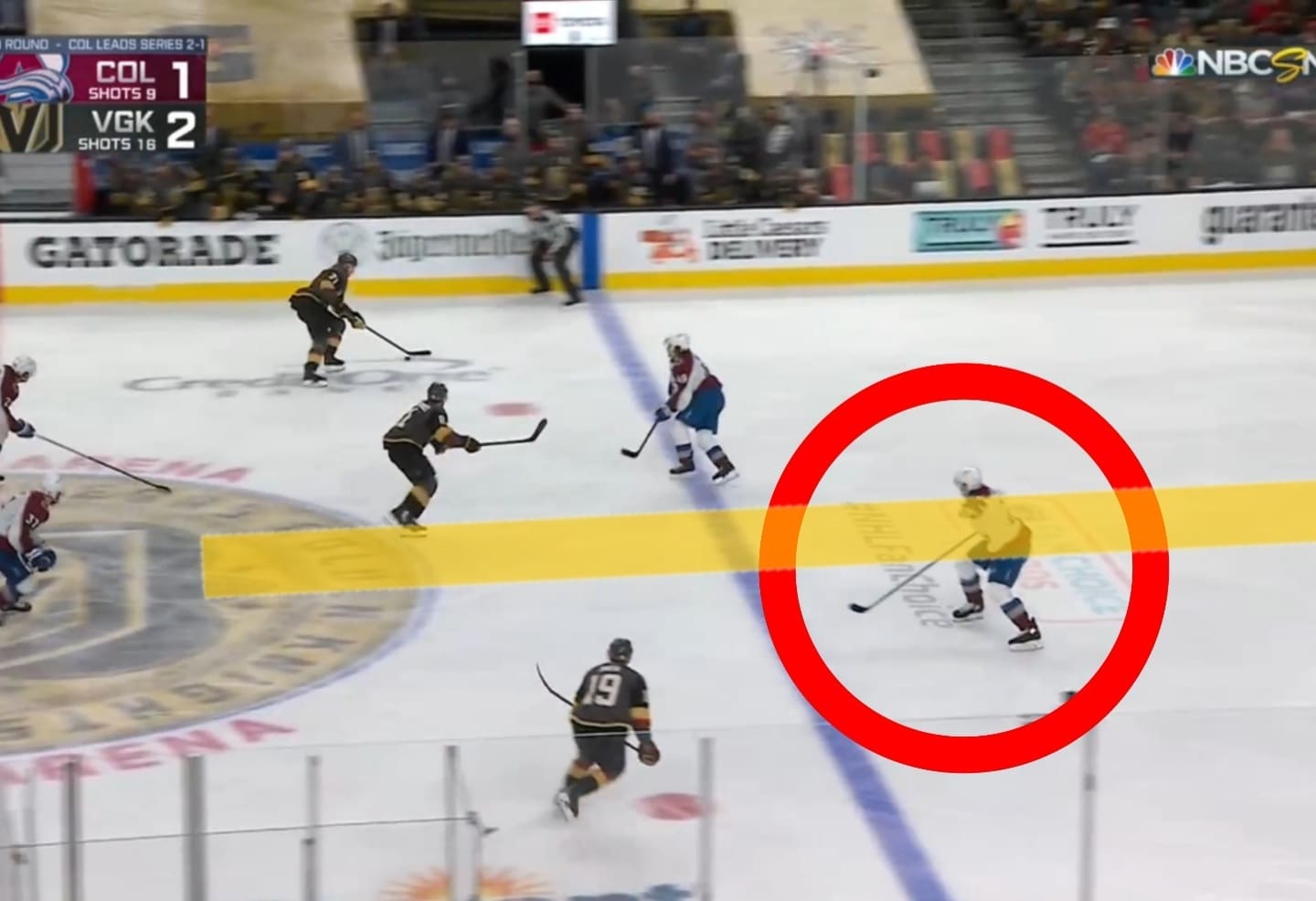
CLEAR AS DAY as he notices the 3-on-2, he signals to Compher (orange) to pick up Graves’ man (Reilly Smith #19) as he cuts in to help Girard late off the rush. The only issue is, Compher in this scheme is the ‘F1’, meaning that his job is to also protect the middle and high slot but also attempt to disrupt the primary puck carrier, which happens to be his direct match-up, William Karlsson. He’s also too far behind the play for Graves to make the assumption he can impact the play defensively.

As the Avs clear their own zone later in the play, Girard and Graves assume that danger has subsided and collectively don’t create a good distance between their gaps. That gap control and pairing distance go out with the old Pepsi Centre sign; into the trash. Graves pokes and prods, gets turned around and the middle ice behind him is more open than the Simpson Desert, mate.
This is all things bad and all things lucky in the same breath. Speaking of lucky, check out slotxo for fun games to play.
Play #2
This shouldn’t happen this easily from an OZ draw.
When Girard draws down the wall, Mikko Rantanen switches up high to the point, but that isn’t the problem here. This is a set play they run often with good results. What the negative is on this play is assumptions and poor choice of ice management. Landeskog and MacKinnon are creating traffic for what they think is going to be a point shot from Rantanen or a quick wrister from Girard. But as soon as Girard advances the puck and decreases an optimal shooting angle, all three of Girard, Landeskog and MacKinnon end up vacuumed behind the play once Girard’s floater is blocked by Stone.
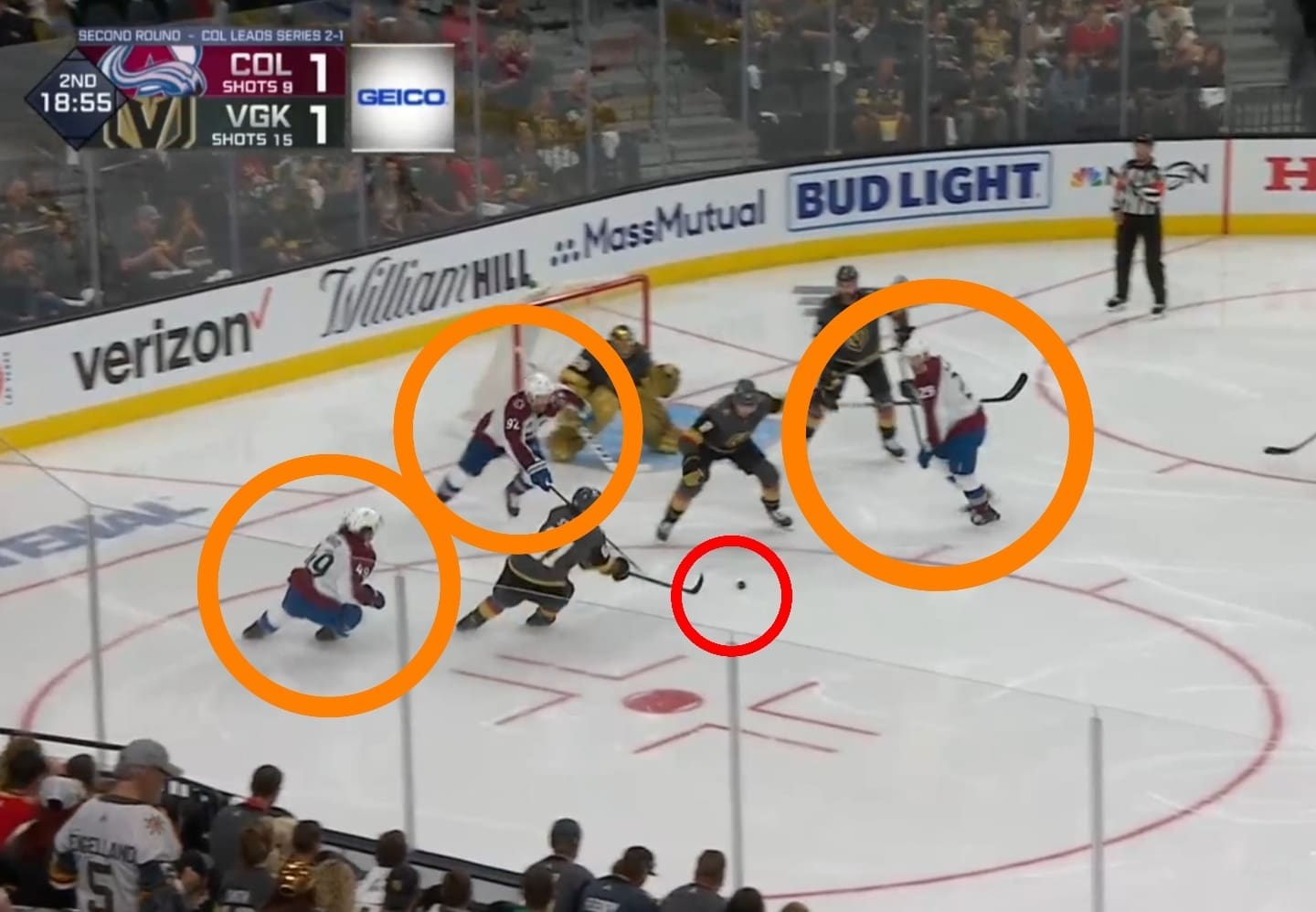
This leaves Mikko flat-footed as the left-hand defenseman as the rush begins. Makar is faced with a 3-on-2 with Rantanen to his left side. He chooses to step up into the puck carrier Stone as he passes the middle line but his sweep is unsuccessful and it leaves Pacioretty with space down the left wall.
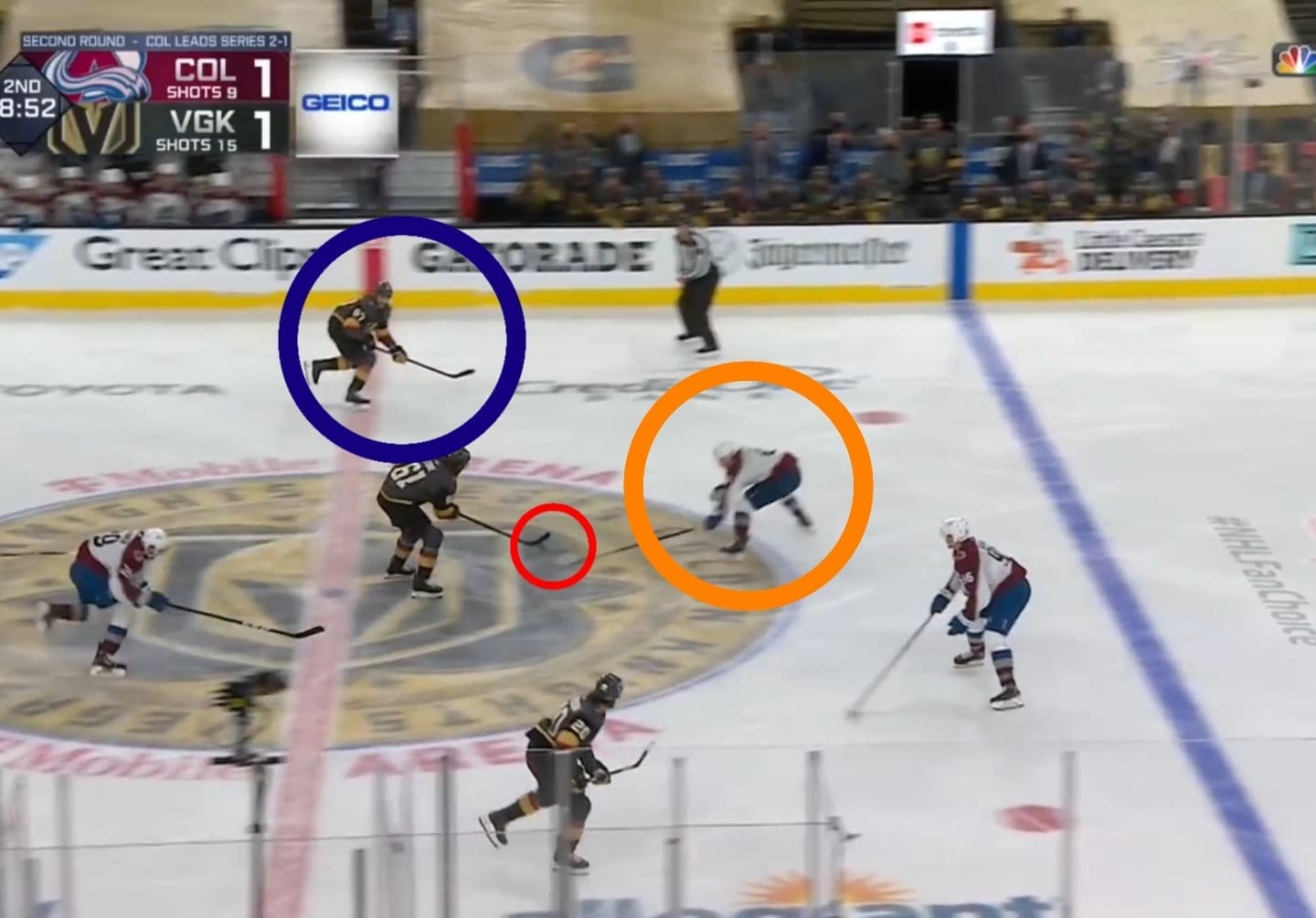
Stone drives the middle as the play continues and Pacioretty has just enough room to sneak a soft-ish goal glove side high on Grubauer.
This play is relatively bad luck, but the lack of man-on-man recognition in the offensive zone is poor. Too many stagnant bodies and improper puck management leads to an easy breakaway.
Play #3
Avs’ are working well here down three goals, throwing pucks on net and trying to establish some possession.
As they battle in the corner, Rantanen (orange circle) applies a soft contain on Stone (blue circle). But what I don’t like is the fact he doesn’t seem to recognize the handedness of Stone. As a right-handed shot, he’s got his blade pointed to middle ice. He doesn’t have to work south or utilize his backhand to escape or make a pass. Mikko needs space of course as he does want the puck too, but he’s just lacking that exterior defensive acumen on this particular play as you can see below. He needs to be in a position to jam Stone sooner, and for that, he pays the price. Both guys are cheating space, but Stone 1 – Rantanen 0.
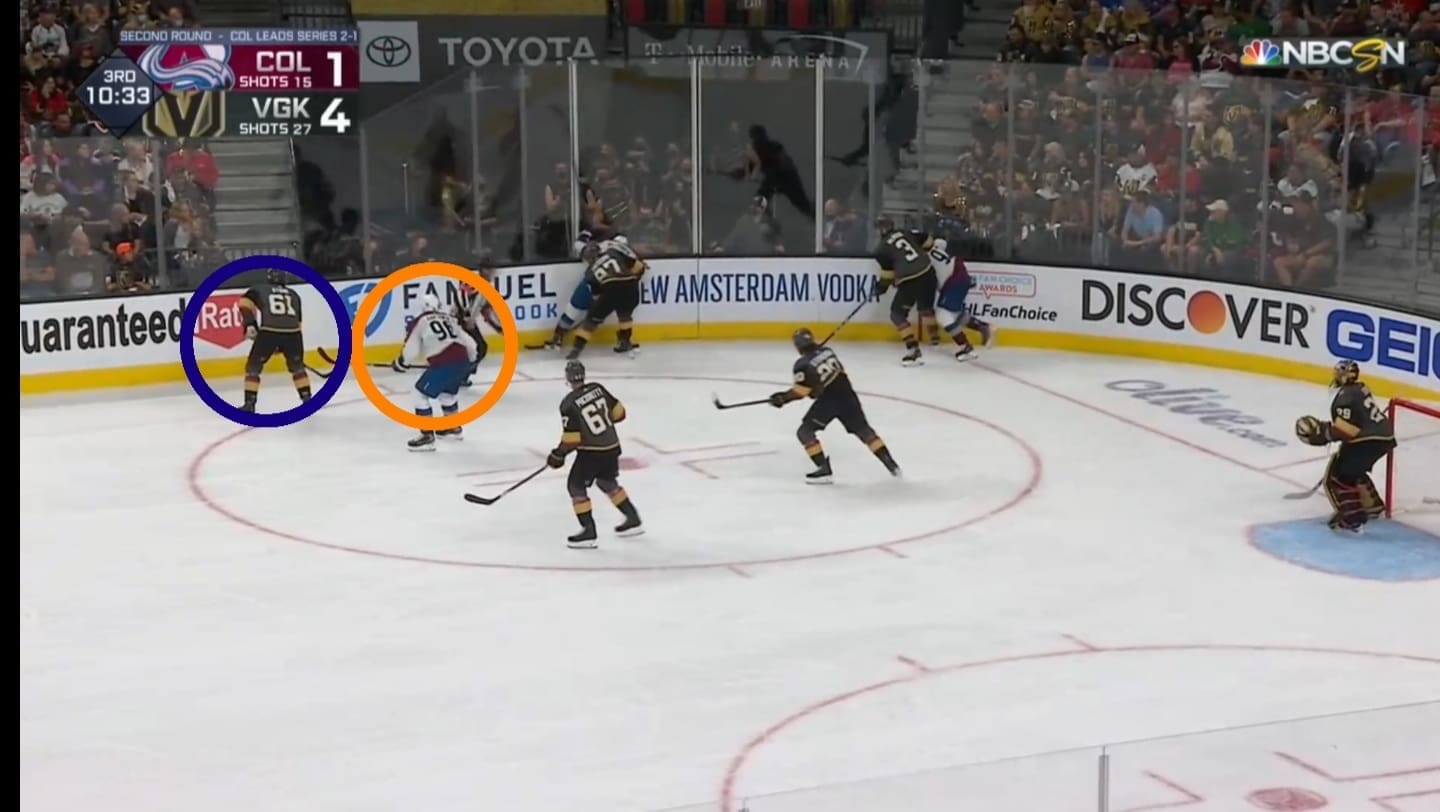
As Stone starts to make his way north, Rantanen finds himself having to defend the cross-ice pass and also tries to keep the zone. This results in him losing balance and thus creating the odd number. Devon Toews has to make a split-second choice as to what to do. At first, he fishes for puck-moving inside but he can’t quite locate it, gets turned around, and bang, there’s your 2-on-1 against.
As the play unfolds, the Avalanche again overplay Vegas. Makar does a heck of a job slowing down Stephenson, but Pacioretty is able to relocate the puck as Makar goes down and both Rantanen and Landeskog get caught hunting the same ground.
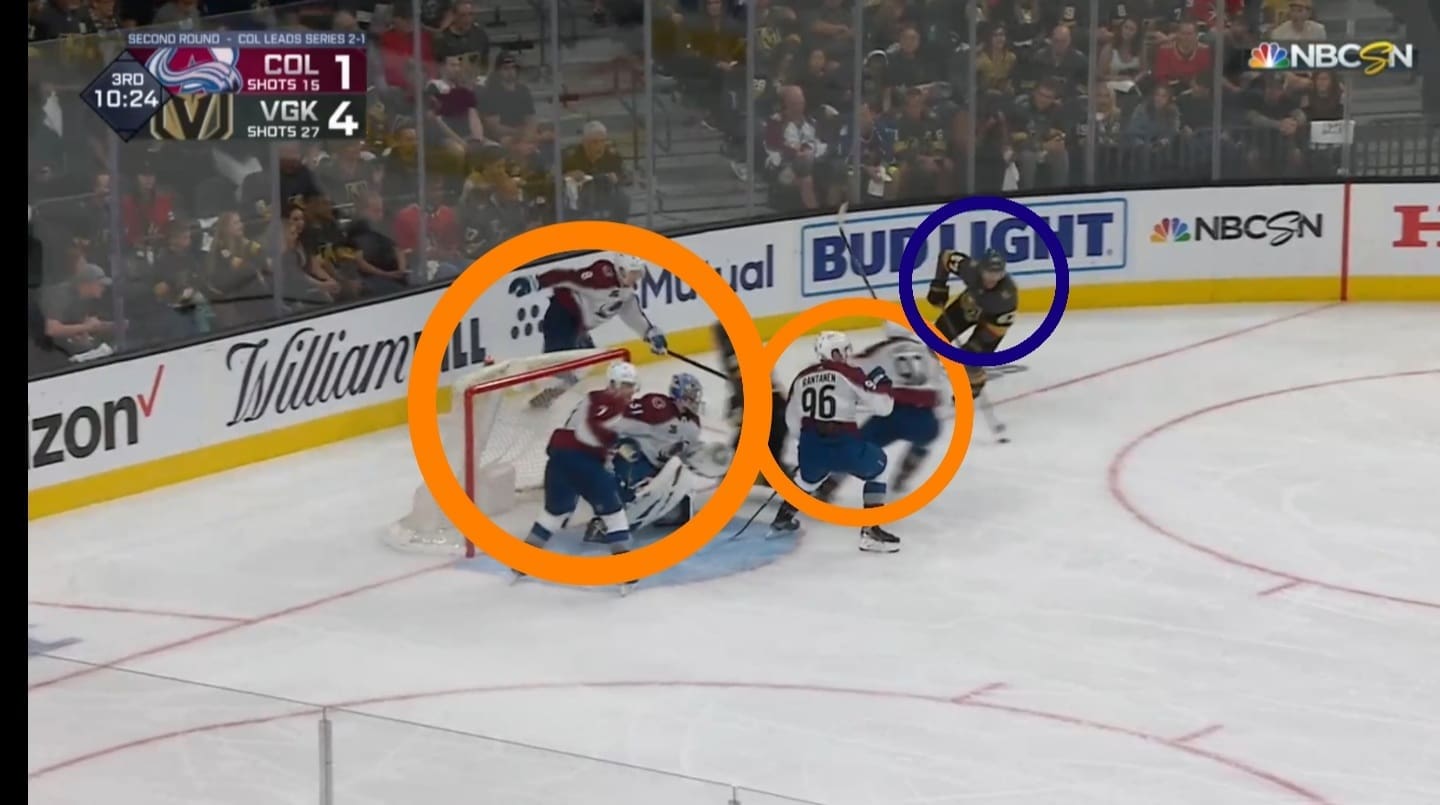
A boatload of space opens up in around the high slot and the vacuum that Colorado create for themselves, sees not-so offensive defenceman Brayden McNabb get a clean look on net, in space.
How To Adjust
First thing that needs doing, get Graves and Girard away from each other.
Of the most common pairs this post-season, they’ve struggled together. Their lack of communication is proven in some of these clips. They just aren’t working well together at the moment.
The pair had a regular-season corsi percentage 55.68 at even strength but have just managed a tick over 47 so far through eight games.
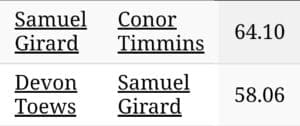

With thanks to Natural Stat Trick, we can see how Girard has faired with others corsi-wise in the playoffs.
Context is important as always. Girard has spent roughly an even 15 minutes with both Timmins and Toews at even strength this post-season, Makar he’s flanked for around 40. However, with Graves’ struggles of late, I’m all for asking some more of Timmins and seeing what he can do with Girard. Or alternatively, try Timmins and Toews as they’ve had some decent success over 18 minutes together.

Toews and Graves have been a total hand grenade when paired together, not going to get into those numbers. It’s beyond bad, trust me on that.
I believe that something in that top four needs changing. They have the talent to mix things up and improve, not many teams boast such a luxury. No time to lose, find what works and stick with it.
Byram for Nemeth is also a no-brainer after Nemo’s nightmare game four.
Re-jigging The Forecheck
The simple old 3-2 forecheck (three forwards in, two defenders out) just isn’t working. Too much space is being given up and it’s a huge problem. I know of two good forecheck strategies that are common and may be able to prevent the Vegas bypass.

Something like this above, a 2-1-2 would be better suited to negate how Vegas have been burning Colorado. The F1 goes hard at the puck (green circle). The F2 contains the weak side and the F3 plays as a spy in the middle. Defenders remain pretty stout as this is more so a forward pressure play.
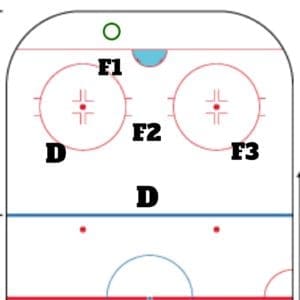
Or maybe a 1-3-1 system should see some action. The F1 attempts to flush the puck and/or puck carrier to one side where either a defender or forward will then increase the pressure and create a blanket around the puck. The 1-3-1 can be both defensive and aggressive, it’s as flexible as you need it to be. How much pressure you apply all depends on possession and numbers in the OZ. For this reason, it’s one of the better forechecks to deploy due to its controllable nature.
I Know, I know
Duh, I’m no head coach. But I’ve had extensive experience scouting, playing and analyzing the game for 15+ years.
Adjustments are needed before the Avs find themselves on the descent.
Let’s see what Bednar and company can cook up. Home ice is a big advantage, time to get back to Avs’ hockey and make the most of it.
Limiting breakaway chances will not only help stem their momentum, it’s going to help eliminate both personal and team shortfalls and keep some gas in the tank. The best way to ease someone in (Byram, cough cough) or to nurse someone through who isn’t playing at their best is to limit those poor offensive plays, provide adequate entry prevention and let the best puck-moving defense in the league get to work.












